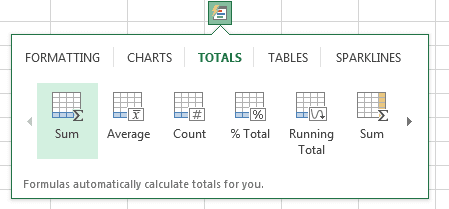Skype group video calling on mobile is planned for full availability worldwide in March. And are available on the App Store for free. 
If the Data Analysis command is not available in your version of Excel, you need to load the add-in program. These instructions apply to Excel 2010, Excel 2013 and Excel 2016. • Click the File tab, click Options, and then click the Add-Ins category. • In the Manage box, select Excel Add-ins and then click Go. • In the Add-Ins available box, select the Analysis ToolPak check box, and then click OK.
Open the Quick Analysis panel by clicking its icon. Then choose a category heading and click an icon for a command. Charts: These shortcuts generate common types of charts based on the selected data.
Quick Analysis In Excel 2010
Tip: If Analysis ToolPak is not listed in the Add-Ins available box, click Browse to locate it. If you are prompted that the Analysis ToolPak is not currently installed on your computer, click Yes to install it. Once the add in has been successfully installed you will see data analysis when you click on the data tab (usually to the far right of the toolbar). Go back to the first screenshot in the instructions to see how it will look. The button will open the Data Analysis dialog, which offers access to a variety of analysis tools.
Quick Analysis is a similar set of tools available in Excel 2013. See for more information. It applies to Excel 2013 and Excel 2016.
Right indent word 2016. ~ Instructions provided courtesy of Excel Help.

Like many of Microsoft’s other Office applications are extremely powerful that have many ‘hidden’ features. I stumbled on the Analysis ToolPak when I took an quantitative analysis class for my Masters program. Once I enabled the add-in and learned how to use the tools it provided, I have not used any other statistical tool except perhaps Minitab, but then I use that for the more complex analysis. The problem with the Excel add-in is that it is not loaded by default, this quickly became a problem for the professor teaching the class because he had to walk everyone through the process of enabling the powerful add-in. I’m posting this quick how-to for those of you that don’t know how to enable it or even know where to locate it. If you have any questions or comments, feel free to post them below. Note: I used Excel 2007 for this guide.
Using OS X As a File Server: Selecting the Mac to Use. For most of us, this decision will be determined by the Mac hardware we happen to have lying around. Luckily, a file server doesn’t need a great deal of processing power in order to perform effectively. For must uses, a G4 or later Mac will more than suffice. I am unable to use the command mount_smbfs to mount a share on a Windows 2008 file server in OS X 10.5.8 Leopard. Here is what I am trying to do: I have a Mac Mini running OS X 10.5.8 that is joined to a Windows 2003 Active Directory domain. I also have a stand alone Windows file server running Windows Server 2008. Before you can browse each computer, you’ll need to enable the ability for both Windows 10 and OS X to see each other. In OS X, launch System Preferences > Sharing > check off File Sharing. Click Options then check off your user account. If you are unable to do this, your iCloud account might be preventing it. Change the Workgroup Name on Your Mac (Snow Leopard OS X 10.6.x) Launch System Preferences by clicking its icon in the Dock. Click the 'Network' icon in the System Preferences window. Select 'Edit Locations' from the Location dropdown menu. Create a copy of your current active location. Click the 'Advanced' button. Select the 'WINS' tab. How to use mac os leopard as a file server for windows.